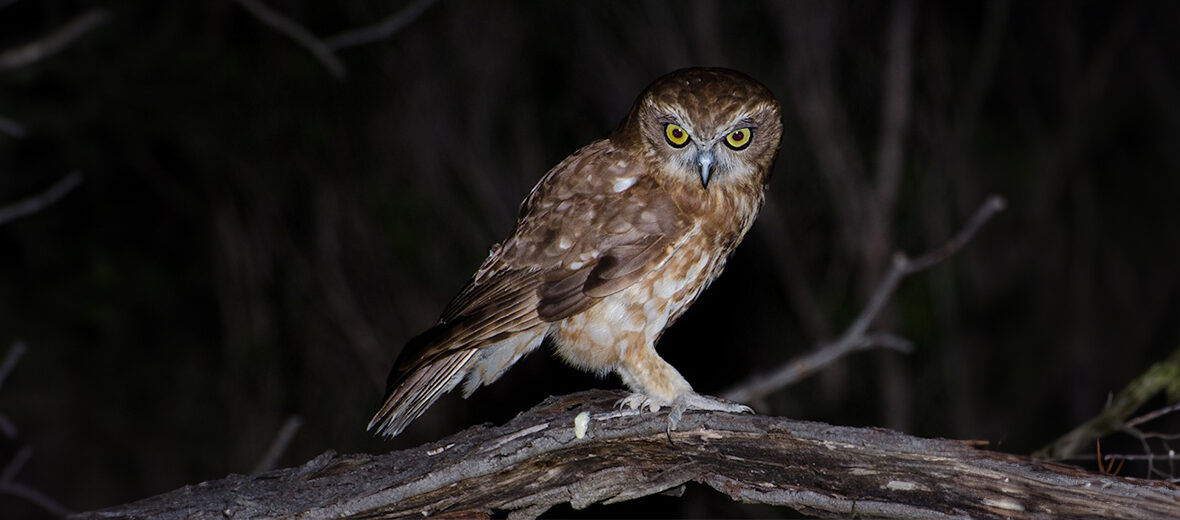
The Australian boobook owl, aka spotted owl and brown owl is the smallest owl found in mainland Australia. Their name hails from the 2-tone “boo-book” call. There are 7 known subspecies of Australian boobooks. They face the threats of habitat destruction at the hands of the logging industry, fires, and fire suppression; invasive species, and with them disease and predation; pollution; and secondary poisoning, by eating freshly killed rodents poisoned by humans. But they are wide spread and thus listed as Least Concern by the IUCN. Their numbers are decreasing though.
First the Stats…
Scientific name: Ninox boobook
Weight: Up to 12.7 ounces
Length: Up to 14 inches
Wingspan: Up to 32 inches
Lifespan: Up to 15 years
Now on to the Facts!
1.) They were first described by John Latham in 1801.
2.) Until 1999 they were thought to be the same species as the morepork of New Zealand.
3.) While primarily nocturnal (active at night), these critters can also be crepuscular (active at dawn and dusk).
4.) The 7 subspecies are N. b. boobook, N. b. cinnamomina, N. b. halmaturina, N. b. lurida, N. b. moae, N. b. ocellata, and N. b. pusilla.
5.) They tolerate a wide range of habitats from eucalypt forests and open woodlands to scrublands and semidesert regions. These owls can even be found in farmlands and suburban areas, as long as there are at least a few trees present.
But wait, there’s more on the Australian boobook owl!
6.) The 2-note “boo-book” call can be heard up to 0.6 mile away; calling from sunset – dawn.
7.) Besides their tell-tale call, they also produce a hoot, a grunt, a croak, and a purring or braying call. High-pitched yelps, growls, and screeches can be produced while attacking intruders.
Did you know…?
Other aboriginal names include: Goor-goor-da (Western Australia), Koor-koo (South Australia), Mel-in-de-ye (Port Essington), gurrgumarlu (Ngarluma people of the western Pilbara), and guurrguurr (Yuwaaliyaay dialect of the Gamilaraay language of southeastern Australia).
8.) They will sometimes allow humans to approach their roosting site as close as 3.5 feet before becoming defensive.
9.) Breeding takes place from July – February.
10.) These owls nest in tree holes up to 70 feet up.
But wait, there’s still more on the Australian boobook owl!
11.) Females lay up to 3 eggs that hatch in up to 31 days, with hatching times separated by a day or more each.
12.) Newly hatched chicks are considered to be nidicolous (leave the nest shortly after hatching).
Did you know…?
Just like most species of owl, these critters are protected under Appendix II of the Convention on International Trade in Endangered Species of Wild Fauna and Flora (CITES) meaning the international import & export of the species is regulated.
13.) The chicks leave the nest up to 6 weeks after hatching.
14.) The young continue to dwell in their parent’s territory for up to 4 months before leaving to find their own territory.
15.) Mice, nocturnal beetles, moths, and smaller birds are all preyed on.
Now a Short Australian Boobook Owl Video!
Be sure to share & comment below! Also, check out the Critter Science YouTube channel. Videos added regularly!
Want to suggest a critter for me to write about? Let me know here.
Some source material acquired from: Wikipedia & IUCN
Photo credit: Richard Jackson



